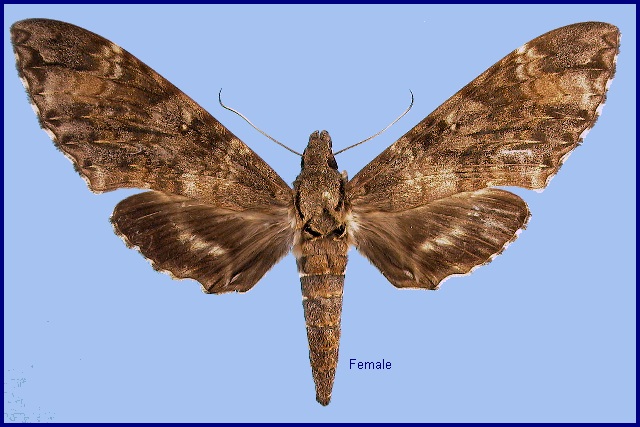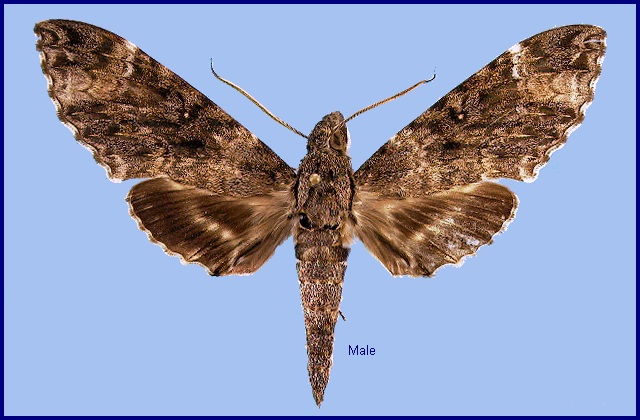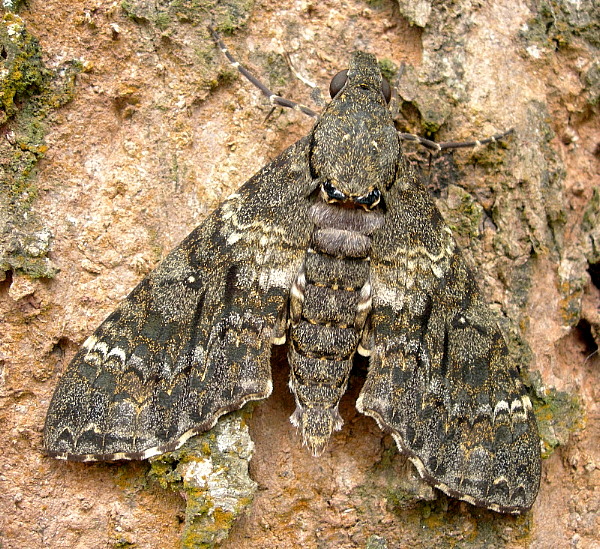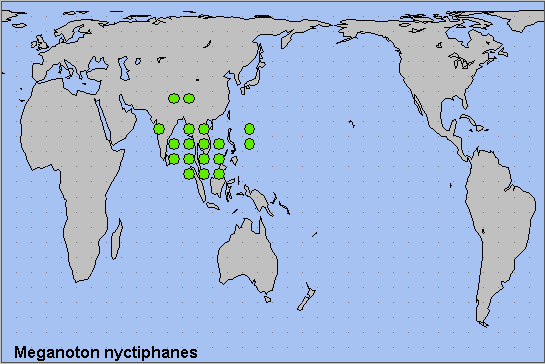

Macrosila nyctiphanes Walker, 1856, List Specimens lepid. Insects Colln Br. Mus. 8: 209. Type locality: [Bangladesh,] Silhet [Sylhet].
Synonym. Macrosila nyctiphanes Walker, 1856.
Synonym. Pseudosphinx cyrtolophia Butler, 1875.
Wingspan: 120--140mm. Forewing upperside with ground colour variable: when paler the lines appear more prominent; outer margin undulate. Hindwing upperside with pale band slightly variable in position. Eye large. Palpus very large, with third segment distinct. Foretarsus with first segment as long as segments 2-4 combined. Hindtarsus segment one with second row of spines beginning in basal quarter. In the male, abdomen with 8th segment laterally tufted; a series of stridulatory scales on the inner surface of each side, not present in the other members of the genus.
In the male genitalia, uncus long, compressed, carinate ventrally, highest beyond middle, strongly curved at base, then nearly straight to apex where it is again curved; tip truncate. Gnathos with lobe broad, long, flat, slightly curved dorsad, deeply sinuate, each half rounded externally, angled at the sinus. Valve broad, dilated dorsad in basal half, the long hair-scales of the dorsal margin and the scales proximal to a patch of modified scales white; the patch of modified scales large, clay-coloured, the scales small, close together, longer than broad, somewhat narrowed apically, bidentate. Harpe with a spatulate process, which is curved dorsad apically, the oblique upper edge irregularly notched and toothed. Phallus with two long processes close together, the longer one denticulate. In the female genitalia, ostial plate much folded, raised mesially from base to ostium. Ostium with proximal edge raised into a double tubercle.

The moth has rather a weak flight. It rests with the wings slanting somewhat broadly and widely penthouse-wise. Bell & Scott (1937) never saw the moth feeding nor coming to light in India.
China: 27.i (Hainan); 31.v (Hainan); 6.vi (Yunnan); 6-25.vii (Hainan); 19-27.vii (Yunnan); 24.viii (Yunnan); 5.ix (Hainan); 3.xii (Yunnan).
OVUM: Green, spherical (1.75mm), surface smooth and shiny. Laid on the underside of a leaf of the hostplant (Bell & Scott, 1937).
LARVA: Full-fed 80mm, width 13mm, length of head 7mm, horn 14 mm. According to Bell & Scott (1937), in the first instar very pale green, becoming darker after feeding; horn straight, black, bifid; the anal flap with a small fleshy protuberance on dorsum. In the second instar basically green with faint oblique lateral stripes; horn black with a broad white subterminal band, tip bifid. The third instar colouring is similar to that of the second instar, but the oblique lateral stripes are more strongly marked; with a protuberance on the dorsum of segment 3. The fourth instar is as per the fifth instar.
In the fifth and final instar, head broadly semi-elliptical in shape, large and powerful. True clypeus one-third length of head; false clypeus a wide arch over apex of true clypeus, reaching to one-half length of head; labrum three-quarters length of clypeus, hind margin gently curved backwards, front margin curved emarginate and half as long is hind margin; ligula in the form of two narrow ovals jointed proximally and diverging distally, hind margin as long as front margin of labrum. Surface of head moderately shiny, with large, low, glassy tubercles interspaced with minute tubercles; labrum with small tubercles on its lateral edges. Body tapering slightly frontad from segment 6; the protuberance on segment 3 a fleshy, triangular, truncated pyramid 3 mm high, flattened in front and behind. Horn rising from a tumidity, straight to near tip, where it is slightly up-curved, tip narrowly and minutely bifid. Body surface smooth and dull with a line of small tubercles starting subdorsally at the front margin of 2, running to the top of the protuberance on 3 and thence to the hind margin of 4. The subspiracular hair on segments 7 to 11 composed of about nine short stems, each of which branches into a much longer fork, the whole spread horizontally into a fan; on 5, 6 and 12 there are only two or three branched stems, on 2, 3, 4, 13 and 14 the subspiracular hair is ample. Horn covered with small glassy tubercles (Bell & Scott, 1937).
Colour of head dark green, the tubercles forming an obscurely grey mottling; labrum and ligula yellow; basal segment of antenna yellow, other segments pale pink; mandible whitish with the edge narrowly and the tip broadly black. Body bright green dorsally, dull green speckled with pale yellow dots laterally, with a yellow line of tubercles on segments 2 to 4. There is a glaucous white dorsal stripe on 6 to 11, and oblique lateral stripes on the same segments, the last running across l2 to base of horn. These stripes may be broad, indistinct and bluish-green in colour, becoming narrow and white near the hind margin of the adjoining segment behind. Alternatively, these may be formed of a quadrate white spot just above the spiracle followed by four or five parallel white lines touched with lilac, or even formed of a few enamel-white spots. Horn bluish-green with the tip green. Legs with basal segments yellowish, other segments dull rose-colour; prolegs and claspers green with the feet livid-white. Spiracles flush, oval, white with a coarse black edge, lying on a larger oval of bluish-green (Bell & Scott, 1937). Illustrated by Eitschberger & Ihle (2019).
On hatching, the larva eats the egg-shell and lies on the underside of a leaf when feeding; however, it usually retires to a secluded twig among thick foliage when resting. It is sluggish, and when at rest raises the fore part of the body from the resting surface, the face parallel with it, the true legs bunched together. When ready to pupate it turns brownish and wanders for some distance from the hostplant. It does not burrow into the earth, but makes a rough cocoon on the soil surface by binding leaves and detritis together with silk (Bell & Scott, 1937).
[Illustrated in Eitschberger & Ihle, 2019]
PUPA: 45--60mm, tongue-case 7-10mm. Colour dark chestnut, paler on wings, darker on tongue-sheath and cremaster; spiracles dull black.
Similar in shape to that of Psilogramma menephron, except for the free tongue-sheath, which is comparatively short and stout; it commences between the eves at right angles to the longitudinal axis of the body, then bends sharply to become parallel with that axis cylindrical near the base and thickens distally to a bulbous tip opposite venter of segment 2; tongue reaches tip of wing-case. Fore leg shorter and mid-leg longer than antenna; coxal piece long and narrow. Surface shiny; frons and a ring round the head smooth; tongue-sheath with basal half transversely lined, the bulbous end smooth; antenna with shallow transverse ridges; legs smooth, costal vein of wing prominent and beaded. The sculpturing on segment 4 takes the form of a rugose half-disc on each side of dorsal line, separated by a depression; the base extends the whole length of the segment, and the rounded end to about three-quarters of the depth of the segment. Thorax rugose, remaining segments pitted, the pitting being most dense at the front margins of the segments; antespiracular ridges on 9 in the form of seven evenly-spaced ridges. Spiracle of 2 oval, with a rough convex surface, the other spiracles oval and sunken, with a large central slit. Cremaster triangular, very rugose dorsally and ventrally, and ending in a smooth round-topped extremity, bearing a pair of short, soft, pale-coloured hairs (Bell & Scott, 1937). Illustrated by Eitschberger & Ihle (2019).
The pupa, if disturbed, makes a hissing noise by moving the abdominal segments 9 and 10 rapidly to and fro, at the same time rapidly contracting and lengthening the abdomen (Bell & Scott, 1937).
[Illustrated in Eitschberger & Ihle, 2019]
Larval hostplants. Recorded from India and Thailand on Symphorema involucratum Roxb. [syn. Congea involucratum] (Fam. Lamiaceae) (Inoue, Kennett & Kitching, [1996] 1997; Eitschberger & Ihle, 2019). In Xishuangbanna, China, on Congea tomentosa Roxb. Also reported from Verbena officinalis Linnaeus (Fam. Verbenaceae).
China: Yunnan (Xishuangbanna Tropical Botanical Garden, Menglun; Xishuangbanna, Mengla; Gaoligong Shan; Yuxi); Guizhou (Banzhaicun, Qiannan Buyei and Miao Autonomous Prefecture); Hainan (Sanya; Baoting Li and Miao Autonomous County; Jianfengling National Forest Park; Changjiang Li Autonomous County).
Sri Lanka, India, Bangladesh, Burma/Myanmar, Nicobar and Andaman Islands (Singh, Ahmad & Chandra, 2021), southeastern China, Thailand, Laos (Attapeu), Vietnam (Le & Vu, 2024), Malaysia, Indonesia (Sumatra) and the Philippines (Palawan) (Inoue, 1996).

 Return to Sphingidae of the Eastern Palaearctic species list
Return to Sphingidae of the Eastern Palaearctic species list